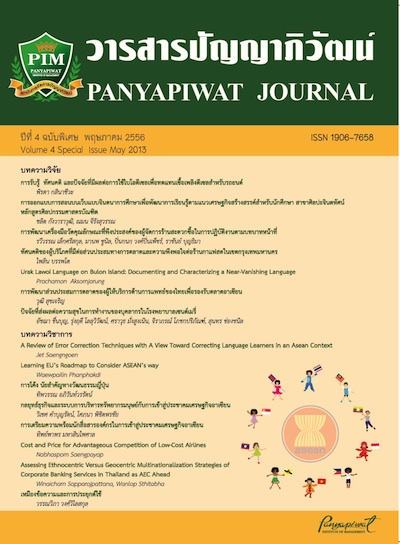A REVIEW OF ERROR CORRECTION TECHNIQUES WITH A VIEW TOWARD CORRECTION LANGUAGE LEARNERS IN AN ASEAN CONTEXT
Main Article Content
บทคัดย่อ
บทคัดย่อ
การแก้ไขข้อผิดพลาดของผู้เรียนภาษาเป็นหัวข้อที่มีการถกเถียงกันอย่างกว้างขวางเป็นระยะเวลาอันยาวนาน ทั้งในมุมมองด้านภาษาศาสตร์ จิตวิทยา และหลักการสอนภาษา ประเด็นดังกล่าวนี้ไม่เพียงแต่เป็นปัญหาสำหรับนักภาษาศาสตร์เท่านั้นแต่รวมถึงผู้สอนที่มีประสบการณ์การสอนอีกด้วย ปัญหาด้านการแก้ไขข้อผิดพลาดในการเรียนภาษานี้ทวีความซับซ้อนมากขึ้น สืบเนื่องมาจากโลกาภิวัตน์รวมถึงการเกิดและขยายตัวของกลุ่มประชาคมใหม่ซึ่งจะส่งผลให้เกิดการเคลื่อนย้ายของบุคลากรอย่างไร้ขอบเขตทางพรมแดนและวัฒนธรรม ตัวอย่างเช่น ในทวีปเอเชีย มีการก่อตั้งสมาคมอาเซียน ตลอดจนปฏิญญาอาเซียนด้านการศึกษาจะก่อให้เกิดส่งเสริมให้เกิดการแลกเปลี่ยนบุคลากรด้านการศึกษาภายในประเทศสมาชิกอาเซียน จากความเปลี่ยนแปลงดังกล่าวนี้จะส่งผลให้ผู้สอนภาษา โดยเฉพาะภาษาอังกฤษต้องเผชิญกับความหลากหลายด้านเชื้อชาติและวัฒนธรรมซึ่งจะก่อให้เกิดความซับซ้อนในการแก้ไขข้อผิดพลาดของผู้เรียนภาษามากขึ้น
บทความนี้มีจุดมุ่งหมายเพื่อวิเคราะห์และสังเคราะห์บทวรรณกรรมทางวิชาการที่เกี่ยวกับการแก้ไขข้อผิดพลาดของผู้เรียนภาษาอังกฤษเป็นภาษาที่สอง รวมถึงการประยุกต์ใช้วิธีการแก้ไขข้อผิดพลาดของผู้เรียนภาษาในบริบทของประชาคมอาเซียน
คำสำคัญ : การสอนภาษาที่สอง วิธีการแก้ไขข้อผิดพลาด บริบทประชาคมอาเซียน
Abstract
A controversial issue that has been discussed in the field of linguistics, psychology, and language teaching is error correction. The issue of correcting errors can be a problematic and prickly issue even for experienced teachers and accomplished linguists. In addition to the already existing controversy over error correction, globalization and the new global community which allow people to move across borders and cultures more easily will create additional problems for language instruction and error correction in particular. In Asia, the ASEAN Declaration promotes the increased mobilization of students and teachers within the ASEAN community. As a result, English language teachers will have to deal with additional challenges when giving corrective feedback in racially and culturally diverse classrooms.
This paper aims to review and analyze the literature on error correction in learning English as a second language and the implementation of error correction techniques in an ASEAN context.
Keywords : Second language teaching, error correction techniques, ASEAN context
Article Details
“ข้าพเจ้าและผู้เขียนร่วม (ถ้ามี) ขอรับรองว่า บทความที่เสนอมานี้ยังไม่เคยได้รับการตีพิมพ์และไม่ได้อยู่ระหว่างกระบวนการพิจารณาลงตีพิมพ์ในวารสารหรือแหล่งเผยแพร่อื่นใด ข้าพเจ้าและผู้เขียนร่วมยอมรับหลักเกณฑ์การพิจารณาต้นฉบับ ทั้งยินยอมให้กองบรรณาธิการมีสิทธิ์พิจารณาและตรวจแก้ต้นฉบับได้ตามที่เห็นสมควร พร้อมนี้ขอมอบลิขสิทธิ์บทความที่ได้รับการตีพิมพ์ให้แก่สถาบันการจัดการปัญญาภิวัฒน์หากมีการฟ้องร้องเรื่องการละเมิดลิขสิทธิ์เกี่ยวกับภาพ กราฟ ข้อความส่วนใดส่วนหนึ่งและ/หรือข้อคิดเห็นที่ปรากฏในบทความข้าพเจ้าและผู้เขียนร่วมยินยอมรับผิดชอบแต่เพียงฝ่ายเดียว”
References
Andringa, S; Glopper, K. D., & Hacquebord, H. (2011). Effect of explicit and implicit instruction on free written response task performance. Language Learning, 61(3), 868-903.
Azizollah, D. (2006). Error correction: Report on a study [Abstract]. Language Learning Journal. 34 (1), 10-13. Retrieved from ProQuest Digital.
Bang, Y. (1999). Reaction of EFL students to oral error correction. Journal of Pan-Pacific Association of Applied Linguistics, 3, 39-51.
Corder, S. P. (1967). The Significance of learner's errors. International Review of Applied Linguistics,(5), 161-170
Dekeyser, R. (1993). The effect of error correction on L2 grammar knowledge and oral proficiency[Abstract]. The Modern Language Journal. 77(4), 501-514.
Gallaher, A. (2007). Explicit grammar Instruction and the learning of phrasal verbs in English [Abstract].
Gass, S. M. & Selinker, L. (2001). Second language acquisition: an introductory course. Lawrence Erlbaum Associates, Inc., New Jersey: Publishers.
George, H.V. (1972). Common errors in language learning. Massachusetts: Newbury House Publishers.
Hawkes, L. (2009). Recasts revisited: The role of recasts in error detection and correction by adult ESL students [Abstract].
Hendrickson, J. M. (2002). Error correction in foreign language teaching: Recent theory, research, and practice. Modern Language Journal, 62(8), 387-398.
Henry, N., Culman, H., & VanPatten, B. (2008). More on the effects of explicit information in instructed SLA: A partial replication and a response to Fernández. SSLA (Studies in Second Language Acquisition), 31, 559-575.
Holley, F. M. & King, J. K. (1971). Imitation and Correction in Foreign Language Learning. The Modern Language Journal, (55), 494-498.
Kamm, R. A. (1990). Reading attitudes in Asian ESL learners. Retrieved May 20, 2011 from http://eric.ed.gov
Loewen, S., Li, S., Fei, F., Thompson, A., Nakatsukasa, K., Ahn, S., & Chen, X. (2009). Second language learners' beliefs about grammar instruction and error correction. The Modern Language Journal, 93(1), 91-104.
Lyster, R. (2001). Negotiation of form, recasts, and explicit correction in relation to error types and learner repair in immersion classroom. Language Learning, 51, 265-301.
Oladejo, J.A. (1993). Error correction in ESL: Learners' Preferences. TESL Canada Journal. 10. 71-89.
Richards, J. C. (2009). Reflective teaching in second language classrooms. Singapore: Cambridge University Press.
Varnosfadrani, A. D. & Basturkmen, H. (2009). The effectiveness of implicit and explicit error correction on learners' performance. System, 37(1), 82-98.

